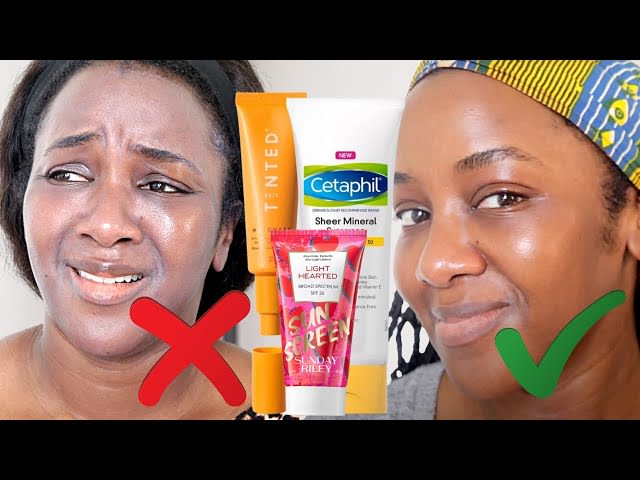Get Your AI Analysis
Personalized skincare insights
Discover your perfect skincare routine with our AI-powered analysis. Get personalized recommendations for glowing, healthy skin.
Start AnalysisFollow Us
Stay updated with the latest skincare tips, trends, and expert advice.
Mineral Sunscreens for Dark Skin: No White Cast Glow
As a seasoned skincare professional with over a decade in the industry, I've seen countless innovations, but few have been as impactful and eagerly anticipated as the evolution of mineral sunscreens for deeper skin tones. For far too long, the mere mention of mineral sunscreen evoked a collective sigh from those with melanin-rich complexions, conjuring images of ghostly white casts that stubbornly refused to blend. It was a barrier, quite literally, to consistent and joyful sun protection. But times, my friends, are changing. We are finally entering an era where inclusive formulation is not just a buzzword, but a tangible reality, especially in sun care.
Today, we're diving deep into the world of mineral sunscreens that are specifically engineered to disappear seamlessly on darker skin, leaving behind nothing but a healthy, natural glow. No more sacrificing protection for aesthetics. No more battling that dreaded purple-gray tint. We’ll explore the science, unveil the ingredients, and recommend the best options that promise high SPF protection without compromising your natural radiance. Get ready to embrace sun protection like never before!
Understanding Mineral vs. Chemical Sunscreens
Before we delve into the magic of no-white-cast mineral formulas, let’s quickly differentiate between the two main types of sunscreens. Chemical sunscreens absorb UV rays and convert them into heat, typically containing active ingredients like oxybenzone, avobenzone, and octinoxate. While effective, they can sometimes cause irritation or allergic reactions in sensitive skin types, and there are ongoing discussions about their systemic absorption.
Mineral sunscreens, on the other hand, are often called physical blockers. They create a protective barrier on the skin's surface that reflects and scatters UV radiation away from the skin. Their active ingredients are zinc oxide and titanium dioxide. These are generally considered safer and gentler, making them ideal for sensitive skin, children, and those with conditions like rosacea or eczema. They offer broad-spectrum protection against both UVA and UVB rays immediately upon application, without needing to be absorbed into the skin.
The White Cast Conundrum: A Deeper Dive
The infamous white cast from mineral sunscreens stems from the nature of zinc oxide and titanium dioxide. These ingredients are white pigments. When applied to the skin, especially in their traditional, larger particle sizes, they simply sit on the surface, creating a visible, often chalky, white or grayish film. This effect is amplified on darker skin tones because of the higher contrast, making it far more noticeable and aesthetically unappealing.
Historically, this was a significant drawback, forcing many with darker skin to opt for chemical sunscreens, even if they preferred a mineral option. However, advances in cosmetic chemistry have brought forth solutions. Micronized and nano-sized particles of zinc oxide and titanium dioxide are the game-changers. By reducing the particle size, these ingredients become less visible while retaining their protective efficacy, allowing for a much sheerer finish.
Why Sunscreen is Non-Negotiable for Dark Skin
There's a persistent, dangerous myth that darker skin doesn't need sunscreen. This couldn't be further from the truth. While melanin does offer some natural protection against UV radiation, providing an estimated SPF of 7-13, it is by no means sufficient for comprehensive defense. Melanin-rich skin is still susceptible to sun damage, including:
Hyperpigmentation: Sun exposure can trigger or worsen post-inflammatory hyperpigmentation (PIH) and melasma, leading to dark spots and uneven skin tone that can be notoriously difficult to treat.
Premature Aging: UV rays accelerate collagen breakdown, leading to fine lines, wrinkles, and loss of elasticity, regardless of skin tone.
Skin Cancer: This is the most critical point. While skin cancer incidence is lower in people of color, it is often diagnosed at later stages, resulting in poorer prognoses. According to the American Academy of Dermatology (AAD), the 5-year survival rate for Black patients with melanoma is 67% compared to 92% for white patients, largely due to delayed detection. Sunscreen is a vital preventative measure for everyone.
Sun protection is not about preventing tanning; it’s about preventing damage, preserving skin health, and maintaining an even, radiant complexion.

Innovative Formulations: The Science Behind No White Cast
The beauty industry has responded to the demand for inclusive sun care with ingenious solutions. Here’s what makes modern mineral sunscreens disappear:
1. Micronized & Nano-sized Particles
As mentioned, reducing the particle size of zinc oxide and titanium dioxide is key. These smaller particles scatter light more efficiently and are less visible to the naked eye, leading to a sheerer application. Rest assured, concerns about nano-particle safety have been extensively researched, and dermatological consensus is that topical application of nano-sized mineral filters is safe, as they do not penetrate beyond the superficial layers of the skin.
2. Tinted Formulations with Iron Oxides
This is a major breakthrough. Many effective mineral sunscreens for dark skin incorporate iron oxides. These are mineral pigments that provide a subtle tint, helping to neutralize any residual white cast and blend seamlessly with the skin’s natural undertones. Beyond aesthetics, iron oxides offer an added benefit: they help protect against visible light, which is known to exacerbate hyperpigmentation and melasma in darker skin types. This makes tinted mineral sunscreens a powerful tool for those managing uneven skin tone.
3. Advanced Dispersal Technologies & Emollients
Formulators use sophisticated emollients, humectants, and emulsifiers to create ultra-smooth, lightweight textures that spread easily and evenly. Ingredients like silicones, squalane, and various plant oils help to disperse the mineral filters uniformly, preventing clumping and ensuring a non-chalky finish. These also contribute to a comfortable wear, often leaving a dewy, non-greasy feel.
Key Ingredients for a Nourished Glow (Beyond SPF)
The best mineral sunscreens do more than just protect; they nourish. Look for formulas that include skin-loving ingredients:
Hyaluronic Acid: A powerful humectant that draws moisture into the skin, keeping it plump and hydrated.
Ceramides: Essential lipids that reinforce the skin barrier, locking in moisture and protecting against environmental aggressors.
Niacinamide (Vitamin B3): An antioxidant that helps reduce inflammation, minimize redness, improve skin barrier function, and even out skin tone.
Antioxidants (Vitamins C & E, Green Tea Extract): These ingredients neutralize free radicals generated by UV exposure and environmental pollution, offering an extra layer of protection and helping to brighten the complexion.
"For my patients with deeper skin tones, the evolution of mineral sunscreens has been revolutionary. The incorporation of iron oxides, in particular, offers not only a cosmetically elegant finish but also crucial protection against visible light-induced hyperpigmentation, a common concern." – Dr. Michelle Henry, Board-Certified Dermatologist.
Top Mineral Sunscreen Recommendations for Dark Skin
Based on their formulation, efficacy, and positive user feedback from diverse skin tones, here are some standout mineral sunscreens that deliver a no-white-cast glow:
Black Girl Sunscreen Make It Hybrid SPF 50: While technically a hybrid, their original broad-spectrum SPF 30 is a cult favorite mineral-based option. It blends seamlessly, leaving no white cast and a dewy finish. They specifically formulate for melanin-rich skin.
Supergoop! Mineral Sheerscreen SPF 30: This 100% mineral formula uses a sheer tint and ultra-light texture to provide broad-spectrum protection that truly disappears on most skin tones, leaving a velvety-soft finish.
EltaMD UV Clear Broad-Spectrum SPF 46 (Tinted): While available in untinted, the tinted version is a dermatologist favorite for its lightweight texture and inclusion of niacinamide. It provides a sheer, natural tint that helps neutralize the white cast for many deeper complexions, though some may still find the tint light.
Paula's Choice RESIST Super-Light Daily Wrinkle Defense SPF 30: This elegant, mattifying formula contains antioxidants and a subtle tint that works well for many medium to deep skin tones, offering a shine-free finish perfect for oily or combination skin.
Unsun Mineral Tinted Face Sunscreen SPF 30: Created by a woman of color, this brand specifically addresses the white cast issue for darker skin. It comes in two tints – Light/Medium and Medium/Dark – designed to blend beautifully without a chalky residue.
How to Choose Your Perfect No-White-Cast Mineral Sunscreen
With so many options, finding your ideal match requires a discerning eye:
1. Check the Ingredient List:
Look for micronized or non-nano zinc oxide and titanium dioxide.
Prioritize formulas that explicitly state “tinted” and ideally contain iron oxides.
2. Consider Texture and Finish:
Do you prefer a dewy, natural, or matte finish? Creams, lotions, and serums all offer different feels.
If you have oily skin, look for oil-free or mattifying formulas.
3. Broad-Spectrum SPF 30+:
Always ensure it’s broad-spectrum (protects against UVA and UVB) and has an SPF of 30 or higher for daily use. If spending extended time outdoors, opt for SPF 50+.
4. Water Resistance:
If you’re active, swimming, or prone to heavy sweating, choose a formula labeled “water-resistant” for 40 or 80 minutes.
5. Patch Test:
Before committing, apply a small amount to an inconspicuous area (like your jawline or behind your ear) to check for white cast and irritation.
Application Tips for a Seamless Finish
Even the best no-white-cast formulas benefit from proper application techniques:
Apply to Moisturized Skin: Sunscreen applies and spreads better over well-hydrated skin. Allow your moisturizer to fully absorb first.
Warm in Hands: Dispense a nickel-sized amount into your palm, rub your hands together gently to warm it up. This helps the formula melt into the skin more seamlessly.
Apply in Sections: Don't apply a large amount all at once. Work in small sections, gently pressing and blending the product onto your skin.
Pat, Don't Rub: For a truly invisible finish, a patting motion can be more effective than vigorous rubbing, especially if the formula is thick.
Allow to Settle: Give your sunscreen a few minutes to fully absorb and settle before applying makeup.
Reapply Diligently: Reapply every two hours, or more often if swimming or sweating. Tinted powder sunscreens can be great for touch-ups over makeup.
"Consistency is key. The best sunscreen is the one you will actually use every single day. Finding a mineral formula that blends seamlessly into darker skin removes a significant barrier to daily sun protection, which is crucial for preventing photoaging and skin cancer." – Dr. Shari Marchbein, NYC Board-Certified Dermatologist.
Addressing Common Concerns
Flashback in Photos?
Traditional zinc oxide and titanium dioxide can cause a white flashback in flash photography. However, the same micronized particles and tinted formulas with iron oxides that prevent a white cast in natural light also help to minimize this flashback effect. Always test a new sunscreen with a flash photo if this is a major concern for you.
Comedogenic Potential?
While mineral ingredients themselves are not inherently comedogenic (pore-clogging), it's the other ingredients in a formula that can be. If you're prone to breakouts, look for sunscreens labeled "non-comedogenic" and "oil-free." The inclusion of niacinamide and other anti-inflammatory ingredients can also be beneficial for acne-prone skin.
Reapplication Over Makeup?
Reapplying liquid mineral sunscreen over a full face of makeup can be tricky. This is where sunscreen powders or mists come in handy. Many brands now offer tinted mineral powder sunscreens that can be dusted over makeup, providing renewed protection and a slight mattifying effect without disturbing your look. Just ensure the SPF is adequate.

